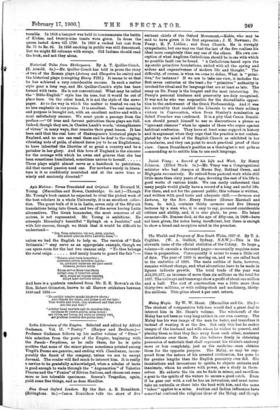Glimpses of Old Bombay and Western India. By James Douglas.
(Sampson, Low, Marston, and Co. 20s.)—It is scarcely neces- sary to say that this volume, which is of goodly magnitude and handsome appearance, contains a number of interesting things, some of them not a little strange in the eyes of the present generation. The India of the first quarter of this century—and possibly the date might be somewhat extended—was socially and politically not a little different from the India of to-day. The rupee, always a disturbing element, was far more troublesome then than now. Between May and September, 1837, it varied from 2s. 3d. to ls. 9d. In 1817 it stood at 2s. 8d. " Give me back 2s. 8d. and 10 per cent. !" was the comment of an old Indian when his nephew described to him recent improvements in Bombay. In those times it was a new thing for England to export cotton goods to India, and for India to export wheat. The first attempt at wheat exporting ended in disastrous failure. " He that deals in corn shall die upon straw," said some wise man of old. Dinners were functions then at which a degenerate age would
tremble. In 1818 a banquet was held to commemorate the battle of Kirkee, and twenty-nine toasts were given. In dress the queue lasted down till 1799. In 1820 a cocked bat cost from Rs. 75 to Rs. 95. In 1856 smoking in public was still denounced. But we might fill columns with scraps. Old Indians should read the book, and not they alone.







































 Previous page
Previous page